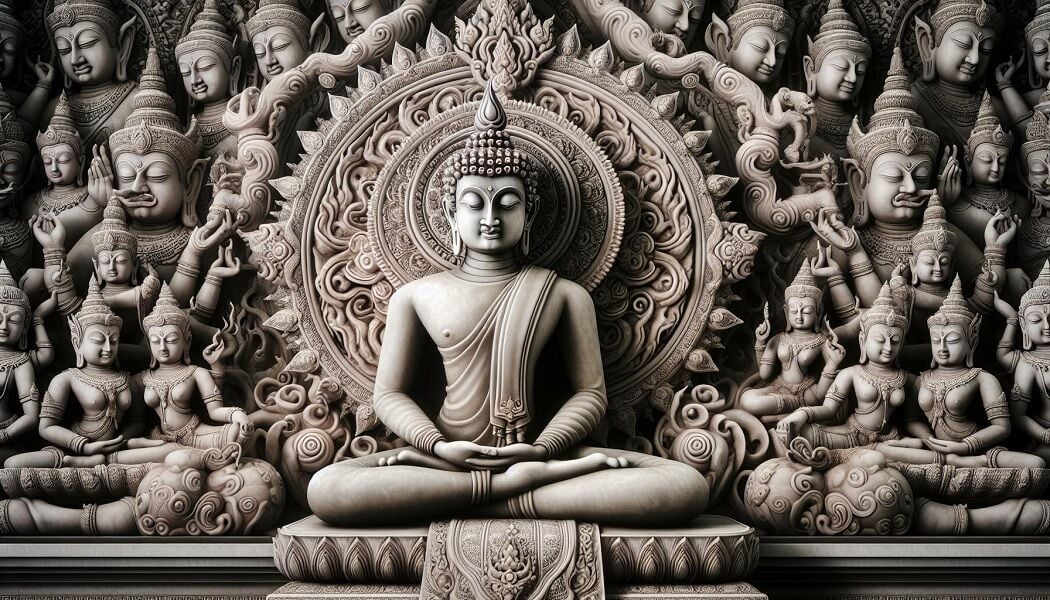Hinduism vs Buddhism: Spiritual journey and global influence

Exploring the spiritual dimensions of Hinduism and Buddhism unveils a complex mosaic of beliefs, practices, and philosophies. For those intrigued by how these two venerable religions compare and contrast, a comprehensive analysis promises an enriching experience. Both emerging from the fertile cultural ground of India, Hinduism and Buddhism share historical ties that intertwine and diverge in fascinating manners. The journey to comprehend the parallels and distinctions between these paths towards enlightenment commences herein.
Upon initial examination, the principles of Dharma in Hinduism and Dhamma in Buddhism appear to serve as a connecting thread between these faiths. Yet, further investigation reveals the subtle differences characterizing each belief system, providing insight into the distinct spiritual frameworks they represent. From Hinduism’s perpetual dharma to Buddhism’s Buddha Dharma, an exploration of these concepts alone can yield significant understanding.
However, this comparison transcends mere philosophical and spiritual discourse. Historical interactions, including disputed narratives of religious conflict and archaeological findings such as stupas, introduce additional complexity to the relationship between Hinduism and Buddhism. In examining 10 similarities and differences, one discovers an intersection where spirituality converges with reality; where teachings inform obligations; and where the pursuit of transcendental truths defines the core of religious identity.
Exploring the historical context
The origins of Hinduism and Buddhism
Diving into the history of Hinduism and Buddhism is like embarking on an exciting journey through their vibrant cultural and spiritual landscapes, which have evolved alongside the amazing civilizations that embraced them. Taking a closer look at where they began is key to really getting how these two captivating religions have danced together yet also charted their distinct paths over the centuries. This journey into their beginnings shines a light on how intertwined yet wonderfully unique each is, adding so much colour to the big picture!
Hinduism, frequently described as the oldest religion globally, traces its roots back to the Indus Valley Civilization around 2000 BCE or before. The religion experienced substantial transformations during the Vedic Period, marked notably by the composition of the Vedas – Hinduism’s most ancient sacred texts. This period represented a critical juncture in its history. Since then, Hinduism has diversified to encompass a broad spectrum of deities, rituals, and philosophical doctrines, all integrated under the principle of Dharma or moral order.
Key philosophical concepts shared by Hinduism and Buddhism

Understanding Karma, Samsara, and Dharma
Diving into the philosophical worlds of Hinduism and Buddhism is like exploring a treasure trove of wisdom, especially when it comes to understanding Karma, Samsara, and Dharma. It’s pretty cool how both these traditions share such similar views! They both celebrate the idea of Karma, basically saying that every little thing we do echoes into our future. In Hinduism, it’s all about how your actions today paint the picture of your tomorrow. And Buddhism? It’s on the same page – doing good brings good vibes and helps guide us towards living our best lives.
Samsara, the concept that talks about the cycle of birth, death, and rebirth, is a belief many share. It’s all about understanding how fleeting our physical world is. People who follow Hinduism and Buddhism are both trying to move beyond this cycle, though each takes its path to do so.
Dharma plays a critical role in both faiths but diverges in interpretation. In Hinduism, Dharma represents duties and righteousness, deeply intertwined with societal roles and personal ethics. Buddhism’s Dhamma, however, focuses on the universal truth and the path to enlightenment. Despite these nuances, Dharma and Dhamma guide individuals towards righteous living and spiritual growth.
The paths to liberation: Moksha and Nirvana
Both Hinduism and Buddhism share a beautiful goal – finding ultimate freedom. In Hinduism, this freedom is called Moksha, which means breaking free from the endless cycle of rebirth by living a life full of goodness, learning to let go and gaining spiritual wisdom. This journey leads the soul to become one with Brahman, the supreme reality. In Buddhism, this kind of peace is called Nirvana, where you find relief from all suffering by understanding and embracing the essence of life. It’s like both paths invite us on an incredible adventure toward inner peace and universal unity!
When we chat about Buddhism, Nirvana is like waving farewell to all those cravings, aversions, and mix-ups. It’s this serene zone where pain and the endless loop of rebirths just don’t exist anymore. You can get there by sticking to the Noble Eightfold Path. Now, if we glance over at Hinduism with its concept of Moksha – which is pretty much about becoming one with a divine force – Nirvana sparkles in its unique way because it’s centred on an individual discovering profound peace and enlightenment solo.
The divine and the universe

Differing views on deities and the cosmos
Diving into the fascinating worlds of Hinduism and Buddhism opens our eyes to how they view the universe and their divine, which is super important because it shapes their traditions and beliefs. In Hinduism, there’s this incredible variety of gods and goddesses that make life a bit more colourful. Imagine having deities like Brahma, Vishnu, and Shiva who are like the superstar team handling creation, upkeep, and transformation of the world. There’s also this cool concept called Brahman in Hinduism—it’s like a divine vibe that flows through everything, showing us how everything is connected in such a deep way.
On the flip side, Buddhism has its unique charm by not focusing on godly worship or believing in a single all-powerful deity ruling over us. It’s all about following Buddha’s wisdom—kind of like having an enlightened friend guiding you away from relying too much on unseen forces for happiness. Buddhism gets right into figuring out why we face tough times and shows us a way to break free from life’s constant ups and downs (that endless cycle called Samsara) aiming for Nirvana—a state where you’re totally at peace because you’ve mastered being mindful and living ethically.
Sacred text and teaching

Analyzing Hindu Vedas and Buddhist Sutras
When exploring the spiritual tapestry of Hinduism and Buddhism, you’ll find distinct paths carved by their sacred texts and teachings. Dive into the Hindu Vedas and Buddhist Sutras to understand how these religions guide the pursuit of enlightenment and moral conduct differently, yet with a shared reverence for spiritual wisdom.
Hindu Vedas
The Vedas constitute the foundational core of Hindu culture, encompassing a wide spectrum of knowledge from profound spiritual insights to detailed ritualistic instructions, alongside contemplations on existential queries. Authored in the elegant Sanskrit language, these ancient texts are categorized into four distinct compilations: the Rigveda, Yajurveda, Samaveda, and Atharvaveda. They delve into the exploration of the divine and articulate the cosmic principle known as Rta. Enriched with hymns, incantations, philosophical reflections, ritual guidelines, and discourses on life and the cosmos, these scriptures serve as an essential guide for leading a virtuous existence by comprehending immutable truths embedded within the cosmic order.
Buddhist Sutras
Hey there! So, when we dive into Buddhist teachings, the cool thing is that they’re mainly found in the Sutras. These texts are pretty special because they share the wisdom of the Buddha himself, Siddhartha Gautama. Now, unlike the Vedas which are like a mixtape of different sources from over time, Buddhist Sutras give us a straight shot at understanding enlightenment (Nirvana) and how to get there. They lay out some key ideas – think of them as life hacks for inner peace – called the Four Noble Truths and the Eightfold Path. These are super important for helping folks break free from life’s ups and downs (Samsara) and find true happiness. The Pali Canon, which includes stuff like the Sutta Pitaka, along with Mahayana Sutras, are like the go-to guides or foundational texts that Buddhists all over tap into for some deep philosophical insights on their spiritual journey.
Practices and rituals

Similarities in meditation and yoga
Did you know that Hinduism and Buddhism share a close bond regarding meditation and yoga? Both of these practices are super important in helping folks from both religions grow spiritually. Meditation is all about reaching this awesome state of mind where everything feels elevated. In Hinduism, it’s often mixed with yoga to help guide people toward Moksha, which is like achieving ultimate freedom. On the flip side, Buddhists lean into meditation to be more mindful and touch base with Nirvana, which means breaking free from the endless loop of rebirth.
Diverse ritual traditions
Hinduism is like a vibrant tapestry of rituals, weaving together everything from simple daily prayers and offerings to the grandeur of festival ceremonies. These beautiful practices are deeply rooted in ancient texts called the Vedas and play a key role in worship, purifying hearts and minds, and marking life’s big moments like births and weddings. It’s more about finding peace through meditation, chanting together in harmony, and living by ethical guidelines that light the way to enlightenment. But don’t think rituals are off the table in Buddhism! In Mahayana Buddhism, rituals shine brightly with meaningful ceremonies and visual journeys that bring Buddha’s teachings to life.
The societal framework

The caste system in Hinduism and Buddhism’s response
Hinduism brings us the caste system, a way of organizing society that sorts people by their family background. In this setup, we have the Brahmins, who are like the heart of spiritual guidance or priests in the community; then there are the Kshatriyas, known for their bravery as guardians and warriors; the Vaishyas play a key role in keeping the economy buzzing with their business and trade activities; and lastly, the Shudras, who take care of all sorts of important jobs that help keep our society running smoothly.
With the advent of Buddhism, founded by Siddhartha Gautama—widely known as Buddha—a significant shift in perspective towards social stratification was observed. Buddha critically examined the rigid social hierarchies inherent to Hinduism and proposed an alternative viewpoint. He advocated for universal respect and kindness irrespective of one’s background. Emphasizing compassion and self-improvement as vital components for attaining Nirvana, he posited that an individual’s conduct and treatment of others hold greater significance than their assigned social category.
Symbols and iconography

Common symbols: The lotus flower and the mandala
In the spiritual landscapes of Hinduism and Buddhism, symbols serve as profound conveyors of philosophical truths and spiritual wisdom. Among these, the lotus flower and the mandala stand out for their shared significance and distinct interpretations within each religion.
The lotus flower, revered in both Hinduism and Buddhism, symbolises purity, enlightenment, and rebirth. In Hinduism, it is often associated with deities like Brahma and Lakshmi, highlighting notions of creation, beauty, and prosperity. The lotus’s ability to rise from the murky water unscathed is paralleled to the human journey towards spiritual enlightenment, transcending the murkiness of material existence.
In Buddhism, the lotus carries a similar metaphor for the rise of the soul. It represents the potential for individuals to rise above the suffering of life’s cycles to achieve enlightenment. The Buddha is frequently depicted seated on a lotus, symbolising his divine birth and purity amidst the worldly murk.
The mandala, another profound symbol, embodies the universe’s complexity in both religions. In Hinduism, mandalas are used in rituals and meditation, serving as symbolic representations of the cosmos and as tools for spiritual guidance. They are intricate, geometrical patterns that symbolise the interconnectedness of all life, illustrating the universe’s cyclical nature and the eternal cycle of birth and rebirth.
The role of monastic life

Asceticism and the pursuit of enlightenment
In both Hinduism and Buddhism, monastic life holds a paramount position in the pursuit of spiritual enlightenment. However, the paths and practices within each religion show distinct characteristics that define their unique spiritual landscapes.
In Hinduism, asceticism embodies the renunciation of worldly pleasures and ties, a key step for those seeking Moksha, or liberation from the cycle of rebirth. This pursuit involves strict discipline, chastity, and simplicity, often leading seekers to adopt a life of wandering or living in monasteries dedicated to meditation and the study of sacred texts. The ascetic, known as Sannyasi in Hinduism, aims to transcend physical needs to attain spiritual realisation.
Buddhism, on the other hand, places the monastic community, or Sangha, at the heart of its spiritual practice. Monks and nuns adopt the monastic life to live out the teachings of the Buddha, dedicating themselves to a disciplined lifestyle that includes celibacy, living on alms, meditation, and mindfulness practices. The Buddha’s Dharma is their guide, aiming for Nirvana, the ultimate state of liberation and freedom from suffering.
Modern-day presence and influence

Global spread and cultural integration
Hinduism and Buddhism, two of the world’s oldest religions, have extended far beyond their origins in the Indian subcontinent, fostering a broad cultural influence and integration across the globe. Their modern-day presence underscores a remarkable journey of spiritual dissemination and adaptation, offering insights into the dynamics of cultural exchange and religious practice in a globalised world.
Hinduism, with its rich tapestry of deities and philosophies, has found a vibrant expression in countries like Nepal, Bangladesh, Indonesia, and parts of the Caribbean and Africa. This spread, primarily through Indian diaspora communities, has led to the establishment of grand temples and the celebration of Hindu festivals, such as Diwali and Holi, with fervour around the world. These observances not only enrich local cultures but also highlight Hinduism’s adaptability and enduring appeal.
Buddhism, for its part, has seen a significant expansion in East and Southeast Asia, most notably in China, Japan, Korea, and Vietnam, where it has taken root in the cultural fabric of these societies. The transplantation of Buddhism into Western countries, notably in Europe and North America, underscores its universal message of peace, mindfulness, and the pursuit of enlightenment. Buddhist meditation practices and philosophies have gained widespread acceptance, influencing health, wellness, and spiritual exploration beyond traditional religious contexts.
Yoga, often underestimated by old people, unlocks remarkable benefits. It enhances flexibility, strengthens balance, and boosts mental wellness. Tailored poses ensure safety, promoting a healthier, more vibrant lifestyle. This gentle practice not only rejuvenates the body but also enriches the spirit, proving its transformative power for old people.

































